Continuous Lava Flow on Which Island
UPDATE: The ongoing summit eruption of the Kīlauea Volcano remains confined within the Halemaʻumaʻu crater. Read more about how to see the lava lake here.
Lava viewing is a must-do activity if you are lucky enough to be on the Big Island while one of the volcanoes is actively erupting. Hawaii wouldn't exist if it were not for the continuous volcanic activity that created all the islands, and seeing this happening in "real-time" is, for many people, a once in a lifetime experience.
Table of Contents
- Lava FAQ
- Is there lava now?
- Lava tours and DIY lava viewing
- Where to see lava now (2022)
- The Kilauea Volcano: Ongoing and Past eruptions
- Lava safety
Lava Questions and Answers
We strive to make our lava viewing guide as complete as possible, which means that it sometimes can be difficult to quickly find the information you are looking for. Because of this we answer some of the most asked (and answered!) questions about seeing lava in Hawaii below:
Yes! The currently ongoing eruption is contained within the Halemaʻumaʻu crater. Check out our often updated viewing tips for how to best see the lava.
The current eruption is located within the Halemaʻumaʻu crater and hiking there is not possible. See our guide to hiking to the lava flow to learn about your options when lava moves outside of the crater.
We do not recommend paying for a lava tour if your only goal is to see lava because you can easily and safely do this yourself. If you are rather looking for the added value of an "everything arranged" day tour where you learn about and see many aspects of our volcanoes have a look at our guided volcano tours section.
Short answer: no. Lava boat tours are only organized when lava flows into the ocean. For a longer answer see our tips for choosing a lava boat tour
Following safety directions provided by the Hawaii Volcano National Park staff will allow you to see active eruptions from a safe distance. Read more about how to see lava yourself on our website.
Yes! Kīlauea continues to erupt in the form of a lava lake, and all the lava is contained within the summit crater, Halemʻaumaʻu. Since September 29, 2021, over 93 million cubic meters (24 billion gallons) of lava have erupted. Check out our often updated viewing tips for how to best see the lava.
Set your alarm and go to the park to see the glow before sunrise! Viewpoints like Uēkahuna, Kūpinaʻi Pali and even Keanakākoʻi are packed at sunset, but are usually uncrowded before sun up.
Where is the lava located?
At approximately 3:20 p.m. HST on September 29, 2021 Kīlauea volcano resumed its eruption at the Halemaʻumaʻu crater. Read more about the ongoing eruption here.
This means that the answer to the question "can we see lava in Hawaii?" is "yes!".
-> Current eruption status: there is an active lava lake in the Halemaʻumaʻu crater.
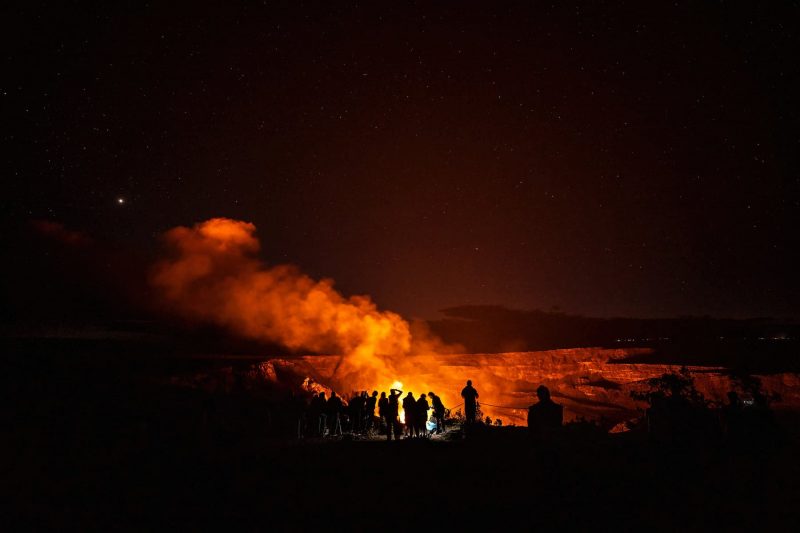
The Keanakākoʻi viewing area is one of the best places to see the glow but can get busy. Try arriving late (after 9 pm) or before sunrise to skip the crowds. NPS Photo/J.Wei
The remainder of our guide is relevant only when lava is visible on the surface.
Lava tours and how to see the lava yourself
Seeing the lava up-close-and-personal is an experience that few people ever forget. How close you can get to the lava depends on where the flow is active, and what lava viewing locations are accessible. Access to the flow could be restricted if local conditions are deemed unsafe or the path to the flow crosses private land. Most of the time the volcanoes on Hawaii erupt at a very calm pace (with 'aloha' if you will), and it is quite easy to get close to the action. We give a very short summary of all options you have to see the lava below:
- From up-close as it flows over the land and/or into the ocean. Conditions permitting, your options are:
- A (guided) lava hike, and
- An ocean lava boat tour.
- From a distance, e.g. with:
- A helicopter tour or
- From a public viewing area / seeing the glow.
- No lava? no problem!
- See the aftermath of the 2018 LERZ eruption
- Or go explore lava tubes and other volcanic remnants
1: Hiking to the Lava: Guided Tours and DIY (when possible)
Hiking to the lava is the best way to get up close. Sometimes, however, lava hikes are not possible because there either is no lava flowing on the surface, or access to the site of the eruption is too dangerous or crosses private lands.
IF access to the flow is possible AND it is on public land you will be able to find several companies that offer guided hikes to the lava flow during daytime or at night.
We describe below both:
- how to hike to the lava yourself, and
- When, why, and how to choose a guided lava tour.
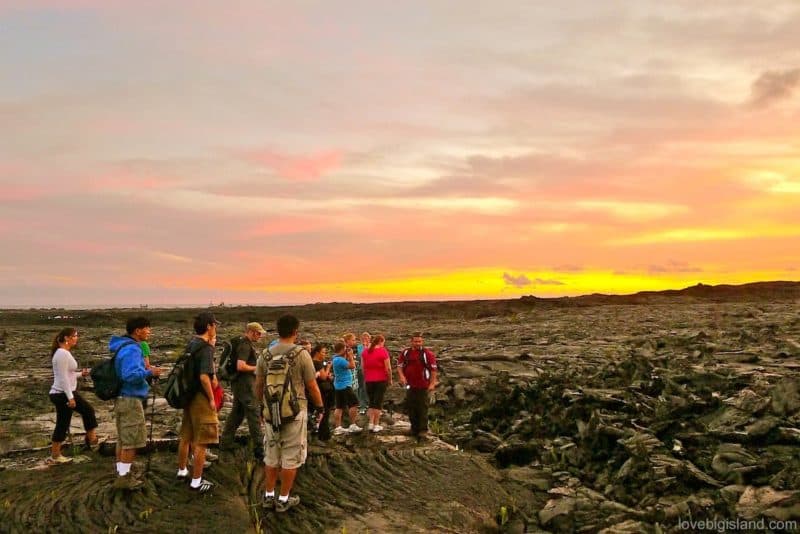
Hiking tours to the lava flow can be tiresome but are worth every drop of sweat!
Hiking to the lava yourself
Sometimes it is pretty straightforward to find your way to the lava yourself and it is good to remember that it is not mandatory to join a lava viewing tour to see the lava. If you do plan for a DIY adventure please make sure to educate yourself on the risks, to dress properly, and to bring plenty of water and sunscreen. A good place to start doing this is by checking out our lava hiking safety chapter.
Besides safety, the most important distinction that determines whether you can hike out to the lava yourself is where the lava is flowing:
- Are the surface flows within the national park boundaries? Yay! If the park determines that access to the flow is safe you can go on a hike to see the lava. Because viewing conditions change on a daily basis you should look up the most recent information about the active surface flows shortly before you plan to see the lava yourself. The Hawaii Volcanoes National Park Visitor Center and the "what's going on with the Volcano" web page of the Volcanoes National Park are good places to do so.
- Are the surface flows on privately owned lands? If the lava is outside of the park boundaries there is a good chance it is on privately owned lands and that you will be trespassing while hiking out. Make sure to get proper permission from the land owners before hiking up to these spots! By far the easiest way to see the lava in this case is to enlist a lava tour guide with proper permissions.
The following video by Ph.D. student-turned-filmmaker Tyler Hulett titled "Dawn of Fire" shows a time-lapse video of the slow-moving lava flows of the Kilauea volcano. This gives a good representation of what you might see when hiking to the lava:
This is one of our favorite videos to watch! It lets you get lost in the lava landscapes of the Kilauea volcano and even after dozens of repeat views we clicking back for more.
Guided Lava Tours
Guided lava tours offer know-how, equipment, and access to restricted terrains where needed. Their guides are trained professionals that know the area intimately. The added value of using a lava tour guide is of course safety, but also getting to know the extremely interesting background information they can provide about the eruption, and, of course, the peace of mind of making a safe trek without getting lost.
These tours can last from 1 hour up to a whole day depending on how accessible the lava is. The hike almost always takes you over very uneven terrain it is important to have an honest conversation with the guides beforehand to make sure you are physically able to complete the hike.
A good option for a guided lava tour that explores the Hawaii Volcanoes National Park and stays in the park after dark to see the glow is the "Twilight Volcano Unveiled" tour by Hawaii Forest & Trail:
Suggested tour
Twilight Volcano Unveiled (Hawaii Volcanoes National Park)
The most in-depth volcano experience on the Island of Hawaiʻi! A national park certified guide shares a mix of natural and cultural history about the island's formation, illuminating the stories behind the ever-changing landscape of our island home.
from: $265 Details
A larger list of outfitters that organize hikes to the lava can be found on the price comparison website hawaiiactivities1. These hiking tours are sometimes combined with other activities so make sure to thoroughly read the descriptions before booking.
Booking a lava hike tour far in advance is risky because at the time of your visit the lava may have stopped flowing. We strongly recommend to that you carefully review the cancellation conditions and, if they are strict, not to book these tours more than a few weeks in advance.
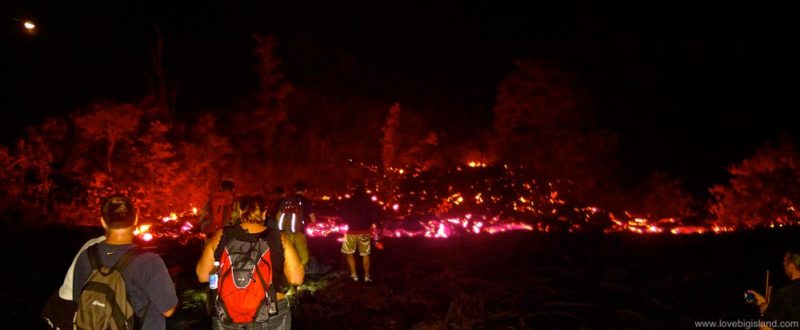
Visiting the Lava with a professional guide is a spectacular experience
2: Lava viewing from the ocean: lava boat tours (currently not possible)
If lava is flowing into the ocean you can enjoy viewing it from a close, safe distance by boat. Definitely a unique and thrilling experience!
Lava boat tours without limited entry approval from the US Coast Guard must keep a distance of 300 meters (984 feet) from the ocean entry point, and outside the designated safety zone (source). Under special circumstances tour operators are granted permission into the lava safety zone and can get closer to the point of ocean entry.
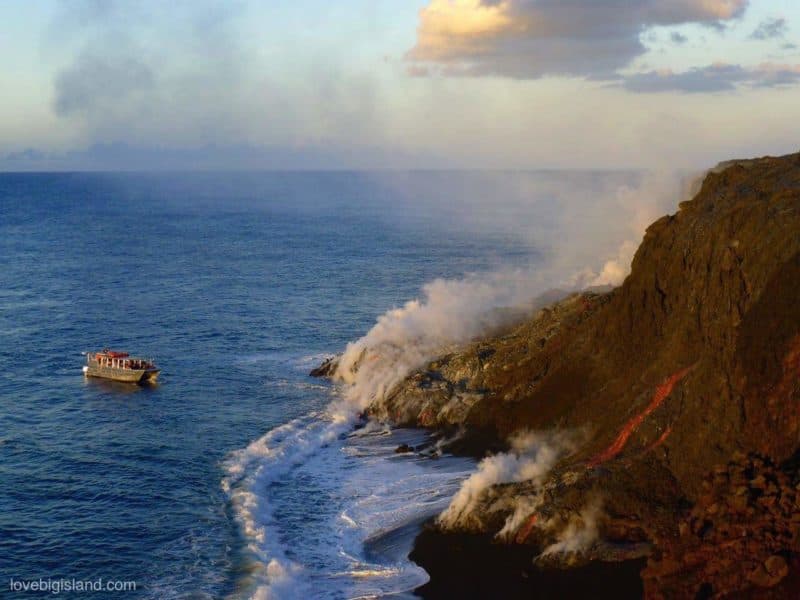
Lava enters the ocean while a lava boat gets close to the action. Photo taken in 2017 during the 61g Kamokuna ocean entry.
Safety and licensed lava boat tour operators
There are many possible risks when trying to see lava enter the ocean which we describe in our lava ocean entry safety guide and it is important that you choose your lava boat tour with care because of the many risks associated with seeing lava this way.
Make sure to always check if your tour operator is licensed to ensure that they possess the experience and training required to get you to the viewing area and back safely.
3: See the lava with a helicopter tour
Helicopter tours let you see the lava and volcanoes from above. A helicopter can get you close to a lot of action that is not accessible over land or water and gives you an impressive birds-eye perspective. Think, for example, about a look into the crater lake, seeing surface lava flows from the air, or lava burning through forests.
Helicopter tours are your best bet to see the lava when other ways such as a hike or boat tour are not possible because they are able to keep a safe distance while still offering an amazing perspective. If this is the case you should plan ahead because helicopter tours can fill up weeks in advance!
Tours that take you to see the lava depart from both Hilo and Kona – the ones from Hilo are shorter and more affordable. Still, helicopter tours are not cheap. The so-called "volcanoes and waterfalls" tours from Hilo start at around $335 for ~55 minutes of flight time.
Suggested tour
Helicopter tours from Hilo
A Helicopter tour to see lava, rainforest and waterfalls. Discover what Kīlauea Volcano has left behind in the wake of its recent historic eruptive episode.
from: $399 Details
Paradise Helicopters (external link) organizes tours that leave from both Hilo and Kona. See also our own guide to helicopter tours on the Big Island for an overview of all helicopter tour operators and tour options.
4: Lava viewing at Public Viewing Areas
Most of the time when lava is flowing on the surface it is possible to see it at a safe distance from a public viewing area. From these areas active lava can be visible directly, or is accessible with a (short) hike. Public viewing opportunities change all the time but an example is the Steaming Bluff overlook of the Halemaʻumaʻu crater in the Hawaii Volcanoes National Park.
How to see the glow in the Halemaʻumaʻu Crater (September 2021 eruption)
Currently there is an active lava lake in the Halemaʻumaʻu crater. At times you can see a sliver of the lake surface from public viewing areas but the main draw is the overwhelming red glow from the lava lake that illuminates the crater walls and the clouds above the lake.
Depending on the conditions (the time of day, the surface and the temperature of the lava lake, and the amount of clouds and their height above the lake) this glow can be seen from miles away. However, the most spectacular views are always available from several of the public viewing areas around the crater.
Our favorite views of the Halemaʻumaʻu crater are from the Kilauea Overlook and the Steaming Bluff overlook, stop #2 on the Crater Rim Drive tour.
During daytime you can see a sometimes impressive plume coming from the crater but the view is truly breathtaking before sunrise and after sunset. At night, the glow of the lava lake colors the steam red, and if the weather is clear this blood-red plume is set against a sky full of stars.
The lava lake is visible from the Kīlauea Overlook, from Uēkahuna (currently closed to protect a pair of native geese that are nesting in the area), and from Keanakāko'i.
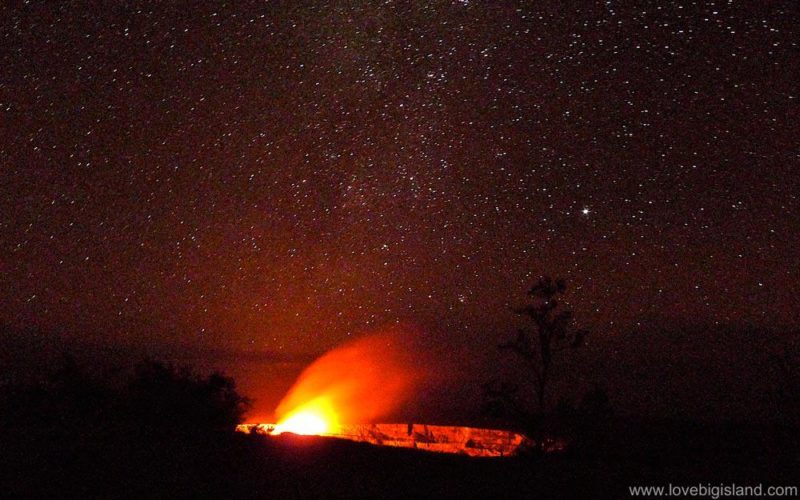
The glow from the Halemaʻumaʻu crater at night in the Volcanoes National Park, seen from the now closed Jaggar Museum overlook.
There is an element of luck involved in trying to see the lava like this because of frequent rains and fog. Weather here at the summit can change quickly though, so try waiting it out for ~30 minutes to see if it clears up.
Please follow the following recommendations to ensure you and all people visiting the park stay as safe as possible:
- Volcanic eruptions can be hazardous and change at any time. Stay on marked trails and overlooks, and avoid earth cracks and cliff edges. Do not enter closed areas.
- Hazardous volcanic gases are billowing out the crater and present a danger to everyone, especially people with heart or respiratory problems, infants, young children and pregnant women.
- Slow down and drive safely. Expect long waits for parking spaces at popular vantage points like Kīlauea Overlook and/or check the parking lot overview on the national park website to see when the typical busy times are.
- Maintain social distance of six feet from others and wear a mask to reduce the spread of COVID-19.
- At 1,219 meters, (4,000 feet), the summit of Kīlauea can be chilly at any time. Bring a rain jacket, wear long pants and closed-toe shoes.
5: See the aftermath of the 2018 LERZ eruption
The 2018 Lower East Rift Zone (LERZ) eruption zone is a very interesting place to visit, as it offers a sobering perspective on the impact of eruptions on the local people and ecology of the island.
Starting in Pahoa you can stop in for a look at the Pahoa Lava Zone Museum. This is a small building featuring artifacts from the last eruption, photographs taken by locals, and exhibits from the now-abandoned Jaggar museum.
From Pahoa you can then follow Highway 132 to the South/East. This road was only recently rebuild over the still-cooling lava flows that covered it in 2018 and it provides some of the best impressions. You can follow this road up to a point that used to be called "4 Corners", but now is only one corner and the end of the road. Be careful with parking and touching the ground because the rocks in the area can still be very hot. From here you can see a panorama of miles of new lava rock. With clear weather you can see all the way to the ocean.
You have probably heard about Leilani Estates, ground zero of the 2018 LERZ eruption and home to Ahu'aila'au (at the time known simply as "Fissure 8"). Leilani Estates is still a residential neighborhood and all roads except for Leilani Avenue are private. You cannot park along Leilani Avenue and the people living here don't appreciate what they perceive as disaster tourism. Please show consideration for the residents and don't drive into the neighborhood. You can see enough of the area while following Highway 130 to the South from Pahoa, for example at Lava Tree State Monument.
Following Hwy 130 further South brings you to Kalapana, after which you can drive up Highway 137 to Pohoiki which was nearly covered by the Leilani Eruption, and has massively changed as a result. This is one of our favorite scenic drives on the island!
Finally, you can also explore some of the properties that were (partially) inundated by lave during the 2018 LERZ eruption as part of a guided tour. See the LERZ4 website for more information.
6: No lava on the surface? No worries!
Even when there are no surface flows, you can still engage in extremely interesting activities to learn about lava and the cultural and natural history of the volcanoes of Hawaiʻi. After all, the Big Island is 100% created by volcanic eruptions, and you don't need to see red-hot lava to be amazed by all the remnants of its creation!
A visit to the Hawaii Volcanoes National Park and/or one of the many lava tubes on our island are good places to start.
Another option is a guided tour. The advantage of these tours is that their guides are expertly trained and provide a wealth of volcano-related information. Volcano-related tours generally take you on fascinating hikes through the park, private lava tubes, and many other stunning places that are difficult to find or reach without a guide.
We list some very well-respected tour operators that offers these tours in our volcano tours section.
Where to see lava now (2022)
Currently there is an active lava lake in the Halemaʻumaʻu crater. During daytime you can see a sometimes impressive plume coming from the crater but the view is truly breathtaking before sunrise and after sunset.
At night, the glow of the lava lake colors the steam red, and if the weather is clear this blood-red plume is set against a sky full of stars. Additionally slivers of the lava lake and occasional fountaining activity are now visible from several vantage points in the park.
Recommended lava lake viewing locations:
The following three locations are our favorite spots to go and see the current eruption. Their popularity means that they can get very crowded during peak hours which are between 6 p.m. and 9 p.m. – avoid these times to avoid the crowds.
The park is open 24 hours a day, and viewing is exemplary both before sunrise and after 9 p.m., weather permitting.
- The recently opened lava viewing area just before Keanakākoʻi Crater. You can get here only after a one-mile walk from Devastation Trail parking lot along old Crater Rim Drive to the viewing area, which is marked by orange candlestick posts. The terrain is rocky and uneven terrain, and bringing a good flashlight after dark is a must! This location is the closest you can safely get to the lava lake, which is about a half mile away. If the Devastation Trail parking lot is full you can park at Puʻupuaʻi and walk an extra half-mile to the Devastation Trail parking lot, to the Crater Rim Drive/Chain of Craters Road intersection, and out to Keanakākoʻi.
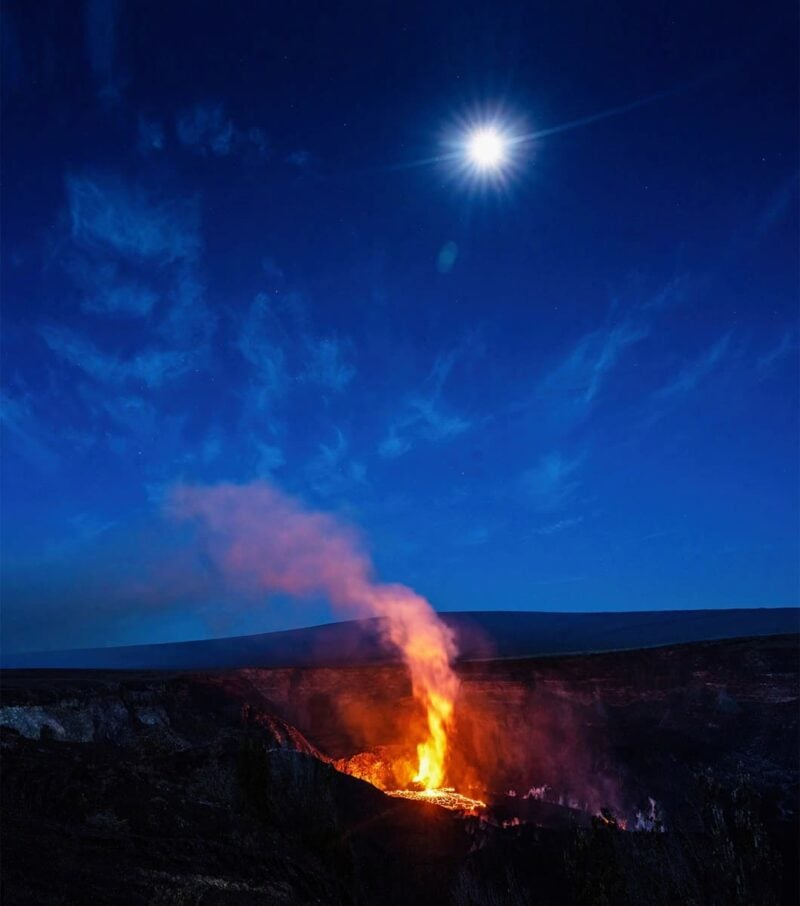
The lava lake in the Halemaʻumaʻu crater as it can be seen from the eruption viewing area near Keanakākoʻi Overlook on November 13, 2021. Image credit: NPS photo/Janice Wei
- Another excellent spot to see a section of the lava lake is from Uēkahuna, the pali (cliffs) near the former Jaggar Museum site. More parking is available here, and it's a short walk on the Crater Rim Trail to the left of the parking lot to the viewing site.
- As of October 24th 2021, the slowly rising lava lake can also been seen from the Kilauea overlook.
See the Hawaiʻi Volcanoes National Park website for a good summary of all 6 overlook locations.
Safety recommendations
Please follow the following recommendations to ensure you and all people visiting the park stay as safe as possible:
- Volcanic eruptions can be hazardous and change at any time. Stay on marked trails and overlooks, and avoid earth cracks and cliff edges. Do not enter closed areas.
- Hazardous volcanic gases are billowing out the crater and present a danger to everyone, especially people with heart or respiratory problems, infants, young children and pregnant women.
- Slow down and drive safely. Expect long waits for parking spaces at popular vantage points like Kīlauea Overlook.
- Maintain social distance of six feet from others and wear a mask to reduce the spread of COVID-19.
- At 1,219 meters, (4,000 feet), the summit of Kīlauea can be chilly at any time. Bring a rain jacket, wear long pants and closed-toe shoes.
Kilauea: ongoing and historic eruptions
There are five (!) active volcanoes in the state of Hawaiʻi: four on the Big Island (Mauna Loa, Kilauea, Hualalai and, still under water but ever growing, Kama'ehuakanaloa) and one on Maui (Haleakalā). The Kilauea volcano is one of the most active volcanoes in the world and is currently erupting.
We summarize for you below the eruptions that took place during the last 100 years:
- The September 29, 2021 eruption in the Halemaʻumaʻu crater
- The December 20, 2020 eruption in the Halemaʻumaʻu crater
- The lower East Rift Zone (LERZ) eruption (2018)
- The 61g eruption (2016 – 2018)
- 7 earlier eruptions
- How to best check the eruption progress yourself (online resources)
1: The September 29, 2021 eruption in the Halemaʻumaʻu crater [ongoing]
At approximately 3:20 p.m. HST on September 29, 2021 Kīlauea resumed the previous summit eruption. The lake has been steadily refilling for over 2 months now, and has risen by 65 meters (213 ft) since lava emerged.
How to see the lava
You can now see a small part of the lava lake from public viewing areas in the park, but the real attraction is the glow coming off the lake and reflecting on the clouds above. Nighttime is the best time to visit for this!
Online resources
In the meantime here are the best places to check for live webcams and the latest updates:
- Kīlauea Summit webcams: https://www.usgs.gov/volcanoes/kilauea/summit-webcams
- Hawaii Volcano Observatory Kīlauea activity summary page: https://www.usgs.gov/volcanoes/kilauea/volcano-updates (also available by phone: (808) 967-8862).
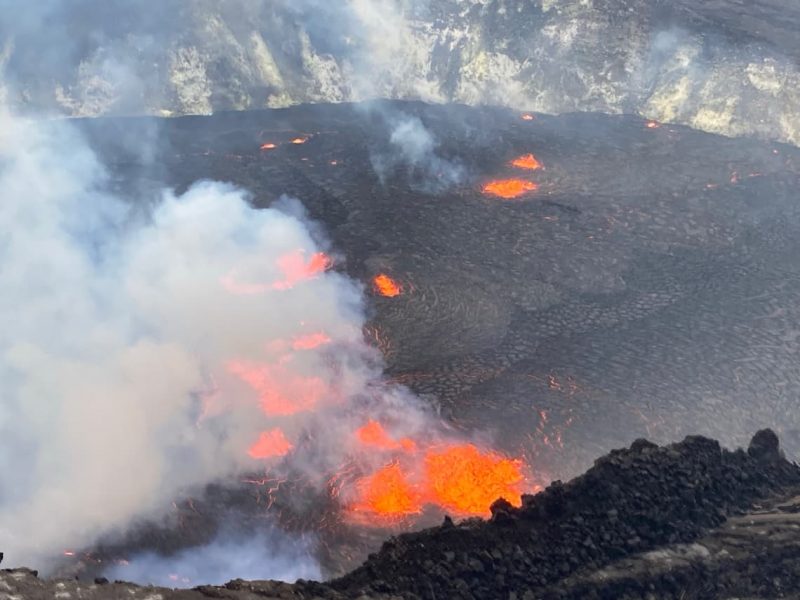
September 29, 2021: Vigorous lava fountains formed in the middle part of the lava lake that was active in Halemaʻumaʻu crater from December 2020 until May 2021. The lava fountains fed lava flows that quickly covered the entire floor of Halemaʻumaʻu crater. USGS image.
2: The December 20, 2020 eruption in the Halemaʻumaʻu crater [ended]
The most recent eruption within the Kīlauea's summit caldera lasted from December 20, 2020 to mid-May 2021. The water lake that was previously forming in Halemaʻumaʻu disappeared and was replaced by a lake of lava. As of May 26, the Hawaii Volcano Observatory announced that the Kilauea Volcano is no longer erupting. Lava supply to the Halemaʻumaʻu lava lake has ceased and sulfur dioxide emissions have decreased to near pre-eruption background levels.
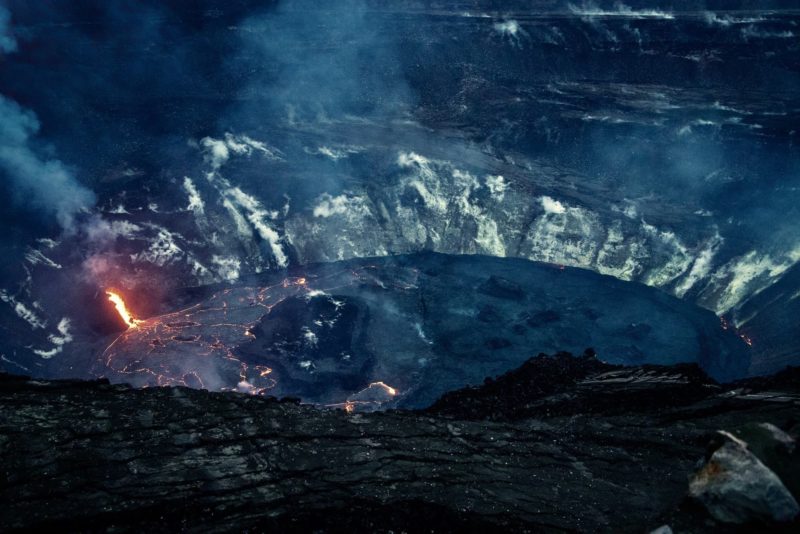
This photo, taken on January 19 2021, shows the slowly filling up Halemʻaumaʻu crater lava lake. This photo was taken by a HVO scientist from a for the public inaccessible part of the park. USGS photo by. H. Dietterich (public domain).
3: Kīlauea Volcano lower East Rift Zone / Lower Puna eruption [2018 LERZ]
The Kīlauea Volcano lower East Rift Zone (LERZ) eruption in lower Puna was preceded by the collapse of the Puʻu ʻŌʻō vent on April 30th and the onset of the draining of the Halamaʻumaʻu lava lake on May 2nd. On the 3rd of May 2018 several fissures in the Leilani Estates subdivision opened, marking the start of this new eruptive episode that didn't stop until early September 2018: the Lower East Rift Zone eruption.
You can also find a really interesting summary of the LERZ eruption summarizing things that we have learned from this event in the journal of Science (our tip: start by browsing the figures and reading the chapter called "Synthesis of 2018 activity" to get a good overview of the article contents). Another good place to learn more is by this cool narrative put together by the USGS.
The 2018 Lower East Rift Zone eruption in numbers:
- 13.7 square miles of land inundated by lava (the surface of almost 6631 football fields!)
- 875 acres of new land created by ocean entries
- 716 dwellings destroyed by lava
- ~30 miles of roads covered by lava
- ~1 billion cubic yards of lava erupted (enough to fill at least 320,000 Olympic-size swimming pools!)
- ~60,000 earthquakes between April 30–August 4, 2018
Videos of the 2018 LERZ eruption
The best way of getting to know a volcano is to see it, and the same goes for individual eruptions. Many impressive and educational videos have been made about this eruption, but we highlight 1 here
ʻAilaʻau: Forest Eater
This is a short film by Lance Page from Page Films that takes viewers on a journey through the infamous 2018 eruption of Kilauea's lower east rift zone. No text but 8 minutes of mesmerizing footage and sounds that make you feel like you were there. Highly recommended!
4: The 61g lava flow [2016-2018]
A breakout from the east flank of Pu'u 'Ō'ō on May 24, 2016 marked the end of another fissure eruption on the flank of the Puʻu ʻŌʻō which started almost two years earlier on June 27, 2014. This was just in time for nearby residents, as the June 27th flow came very close to reaching the city of Pahoa.
This breakout was later named the 61g flow (Episode 61, "g" lava flow). It reached the base of the Pulama Pali by the end of June and entered the sea at Kamokuna on July 26, 2016.
Between July 2016 and March 2018 it was possible to see the ocean entry of lava flow 61g close to Kamukuna both from land and from the sea. In March the up-to-then stable ocean-entry plume stopped being visible, and the Puʻu ʻŌʻō crater collapse on April 30th, 2018 marked the end of the 61g eruption.
The 61g eruption was especially easy to see because the lava was slow-moving and accessible from both sides within the park. The presence of a nearby gravel road made the hike to the flow relatively easy and even allowed bike rentals to operate!
Past eruptions between 1924 and 2018
Kilauea is the youngest and most active Volcano in the state of Hawaii. The oldest lava flows belonging to Kilauea are dated between 210,000 and 280,000 years ago which is pretty young for a volcano. Its eruptions over the last 1000 years have shaped the whole south east side of the island and cover about 90% of its surface.
The last 100 years of volcanic activity can be divided in 7 eruptions. Click on the link in each episode to read an interesting summary on the USGS website.
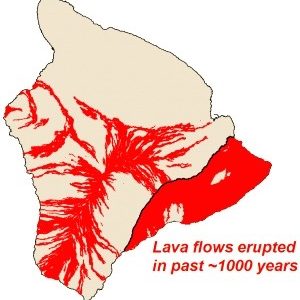
The Island of Hawai'i with lava flows erupted in approximately the past 1,000 years shown in red. Image credit: USGS
- The May 1924 explosive eruption of Kīlauea in Halemaʻumaʻu (with the most powerful explosions at Kīlauea since the early 19th century)
- The Kīlauea 1955 Lower East Rift Zone Eruption in Lower Puna (the first eruption in historic times to occur in any populous area in a U.S. territory)
- The 1959 eruption of the Kīlauea Iki Crater (580 m (1,900 ft) high lava fountains!)
- The 1960 Kapoho eruption (when barriers were built in an attempt to divert lava flows)
- The 1969-1974 Mauna Ulu Eruption (with lava falls higher than Niagara)
- The Kīlauea's summit eruption, 2008 – 2018 (lava lake viewing at the summit!)
- The 1983 – 2018 Pu'u 'Ō'ō Eruption (read more about the latest two episodes below)
Did you know the air force once bombed a lava flow that threatened Hilo in 1935? Read about the Volcanic History of Hawaii in our blog if you want to learn more about the history of all 6 Big Island volcanoes, or the chapter below to learn about the most recent eruptive episodes of the Kilauea volcano:
4: Best online resources to monitor the eruption progress:
You can find a plethora of information about ongoing eruptions online, though not all of it is correct. Unfortunately, many news outlets over-sensationalize events for their own profits, which leads to a lot of misinformation.
Two official (USGS) resources that we keep an eye on and that can help you keep up-to-date with the status of possible ongoing eruptions are:
- The daily Kilauea volcano lava flow update
- The often updated USGS multimedia gallery.
Safety and Practical Information for seeing the lava
Volcanic fumes are hazardous to your health. Persons at risk of respiratory problems or with heart problems, pregnant women, infants, and elderly people, are all discouraged from engaging in this activity. Getting close to the lava flow is both spectacular and risky and it is very important to realize that hiking out to the lava unprepared can put you in harm's way.
You can use the following resources to learn about these safety hazards and how to avoid them:
- Lava safety (hiking)
- ocean entry hazards
- Vog (volcanic smog)
1: Hiking to the lava: stay out of closed areas and be prepared!
We recommended that you wear comfortable socks and walking shoes or hiking boots when hiking out. Pack sunscreen and water together with your camera. If you plan to view the lava flow after dusk, remember to bring one flashlight per person and replacement batteries. The Kilauea is a dynamic volcano, and lava viewing conditions change daily. Even if a viewing area is organized by the National Park, this does not guarantee close access of the lava. Often a 1+ hour hike over hazardous terrain is necessary to reach the flow front of the lava.
If you want to be well prepared take 4 minutes and watch this video about safe lava viewing of ocean entries made by the Hawaii Volcanoes National Park staff. It is especially good to watch if you want to get as close as possible to lava ocean entries while staying safe:
Official "Lava Safe" tips from Hawai'i Volcanoes National Park
We can't overemphasize being prepared for the hike. Far too many times, ill-prepared people (most often tourists) go on a lava hike wearing sandals and flip flops. Such footwear is not appropriate or safe for the rough lava surfaces, and wearing them may force you to return home prematurely without having seen the lava. If you plan on staying past sunset (and we highly recommend this), each person should carry their own flashlight for the walk back (see "Guided lava tours").
2: Safety concerns at the lava ocean entry
Please be aware that lava ocean entries can create extremely dangerous conditions. The two main concerns regarding your safety if you want to see the lava flow into the ocean are:
- The stability of the new land you are standing on (the lava bench)
- The noxious gasses that are released when the lava meets the ocean.
Stability of the new land
Newly created land is inherently unstable and much of the new land will collapse back into the ocean after a while.
Park rangers keep a close eye on the stability of the lava bench and limit the lava viewing area based on what they judge to be safe. This safe distance is based on visual inspection and thermal imaging and is was set, for example, at 1/2 mile or 820 meters for the now now inactive Kamokuna episode (see image below).
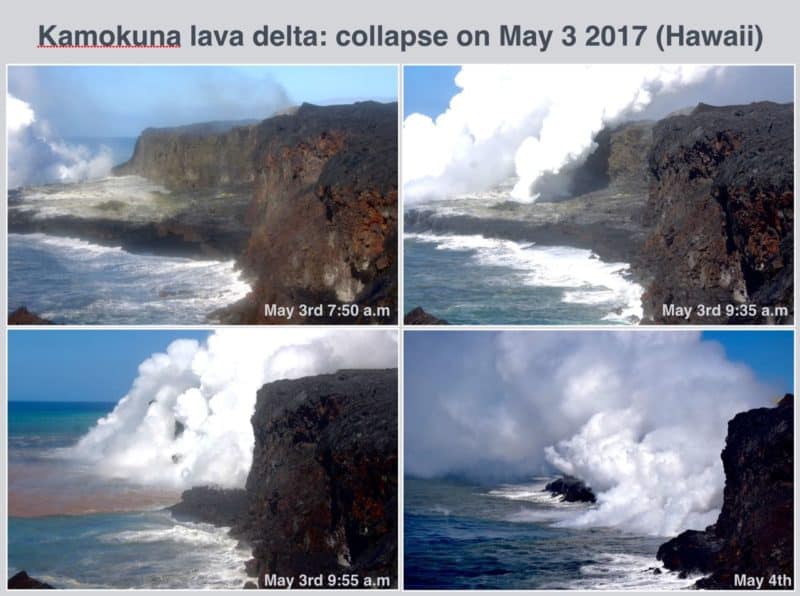
On May 3rd a large part of the Kamokuna lava delta collapsed into the ocean within minutes. Collapsing lava benches can cause a small tsunami and the associated explosions can hurl hot rocks over a large distance. Credit all images: USGS
Collapses like this may even trigger small tsunamis of scalding hot water. Please follow any instructions given by park rangers regarding a safe viewing distance.
Noxious Gases
It is very important to stay away from the plume when you are watching the lava enter the ocean. In general, the wind carries this noxious ocean entry plume offshore and out to sea during nighttime and early mornings. From mid-morning through late afternoon the wind sometimes shifts and carries the plume onshore/along the coast.
The white plume is very hot and contains super-heated steam and many chemicals that range from unhealthy to lethal. The water droplets in the plume can be as corrosive as battery acid. Read more about the dangers of scalding water, steam plumes and poor air quality on the USGS website.
3: Vog (volcanic air pollution)
Contrary to what many may expect, the Big Island has problems with air pollution during active surface flows. This volcanic pollution is called 'vog', a blend of the words "smog", "fog" and "volcanic", and it is so normal here that it is part of the common language on the Hawaiian Islands.
Vog is a form of hazy air pollution much like smog. It is created when sulfur dioxide gas emitted by the Kilauea volcano reacts with oxygen and moisture in the presence of sunlight. Just like smog, there are certain health hazards associated with vog.
You can find voggy conditions in the downwind direction of all eruptive sites. Because the dominant wind directions are east and north-east, the areas most affected by fog are those south and southwest of these sites. The USGS has teamed up with IVHHN/Durham university and HDOH to form the Interagency Vog Dashboard where you can find specific vog advice for visitors to Hawaiʻi.
1. We are part of the hawaiiactivities affiliate program. Read more about our participation. ↩
Source: https://www.lovebigisland.com/big-island-lava-viewing/
0 Response to "Continuous Lava Flow on Which Island"
Post a Comment